Physical Address
304 North Cardinal St.
Dorchester Center, MA 02124
Microsurgical toe-to-hand transplantation allows “like-with-like” reconstruction, achieving the best functional and aesthetic results.
Preservation of neurovascular bundles, flexor and extensor tendons, mobile joints, and viable skin with minimal bone shortening in the amputation stump ensures optimal functional results and less morbidity at the recipient and donor site, respectively.
Retrograde dissection of the vascular pedicle at the first webspace during toe harvest is a key technique to alleviate concerns regarding variations in the vascular anatomy of the donor vessels.
The missing thumb, traumatic or congenital, can be successfully reconstructed with the second toe, great toe or modifications of the great toe including trimmed great toe, partial great toe, and great-toe wraparound flaps.
Missing fingers, traumatic or congenital, can also be successfully reconstructed with various configurations from the lesser toes, achieving good outcomes, especially in those distal to the insertion of flexor digitorum superficialis. Timing of toe-to-hand surgery does not have an effect on flap survival, complications, and secondary procedures.
The “metacarpal hand” refers to a hand with amputations of all fingers proximal to their functional length with or without accompanying thumb amputations. Toe-to-hand transplantation can help restore maximal hand function to this once-crippling condition, even in bilateral defects.
The “metacarpal-like hand” describes a mutilated hand with a wide array of amputations, involving all digits proximal to the functional length except in one finger, or in two digits including the thumb. Strategies in metacarpal hand reconstruction apply, but the reconstruction outcomes of metacarpal-like hand benefit from additional or multiple toe transplants.
Proximal thumb amputations with damage to the basal joint and the thenar muscles continue to be challenging though transplantation of complex toe flaps have been described with simultaneous tendon transfer. Functioning muscles remain of limited application in this group of patients.
Review of our long-term thumb reconstruction (more than 20 years) has further consolidated the reliability and durability of microsurgical toe transfer for thumb amputation/injury at variable levels despite inherent limitations in toe anatomy, and even in those cases with suboptimal reconstruction.
![]()
![]() Access video and video lecture content for this chapter online at Elsevier eBooks+
Access video and video lecture content for this chapter online at Elsevier eBooks+
Microsurgical toe-to-hand transplantation is one of the earliest free tissue transfers dating back to 1966. The technique was first developed to overcome functional deficits following traumatic injury to the fingers and then econgenital deformities, but evolved to address even aesthetic concerns. Over 40 years of history, toe-to-hand transfer has already reached its zenith.
When confronted with digit amputations, replantation remains the standard of care. However, in unreplantable cases or after failed replantation, toe-to-hand transplantation is the next best option superior to the use of prosthesis or other non-microsurgical techniques, fulfilling the “like-with-like” reconstruction principle without the need for immunosuppression.
For replacing a mutilated or unreplantable thumb, microsurgical toe-to-thumb transfer is the gold standard; it is a surgery well justified based on the fact that the thumb constitutes 40–50% of hand function.
For multiple finger amputations, although the resultant disability is comparable to the loss of the thumb and drastically alters the appearance of the hand, indications for microsurgical toe-to-finger transplantation remain controversial. It worth noting that toe transfer to the missing finger distal to the insertion of the flexor digitorum superficialis generally yields superior functional and aesthetic results compared with other techniques.
Single finger amputation is not an exception to multiple finger amputation in controversy, although toe-to-finger transplantation could be indicated to help certain patients keep their jobs.
The metacarpal and metacarpal-like hands represent a more severe and extensive type of injury, and this is a strong indication for toe-to-hand transfer, especially in bilateral injuries. In the era of hand allotransplantation, its indication remains justified for amputations distal to the wrist given the acceptable results without the risk of prolonged immunosuppression.
A critical look at the literature on toe-to-hand surgery may not reveal significant changes since the middle of the 1980s, but it does show slightly increased interest in toe-to-finger transplantation, a sign of change in surgeons' attitudes. It also shows a growing interest in refining the appearance of the transplant hed toe and camouflaging the donor site. Long-term outcomes have also been reported in favor of the procedure, though numbers are small. This chapter outlines the current experience of toe-to-hand transplantations, drawing from the authors' experience of more than 2200 cases over a 30-year period at Chang Gung Memorial Hospital and Medical College ( Fig. 14.1 ).
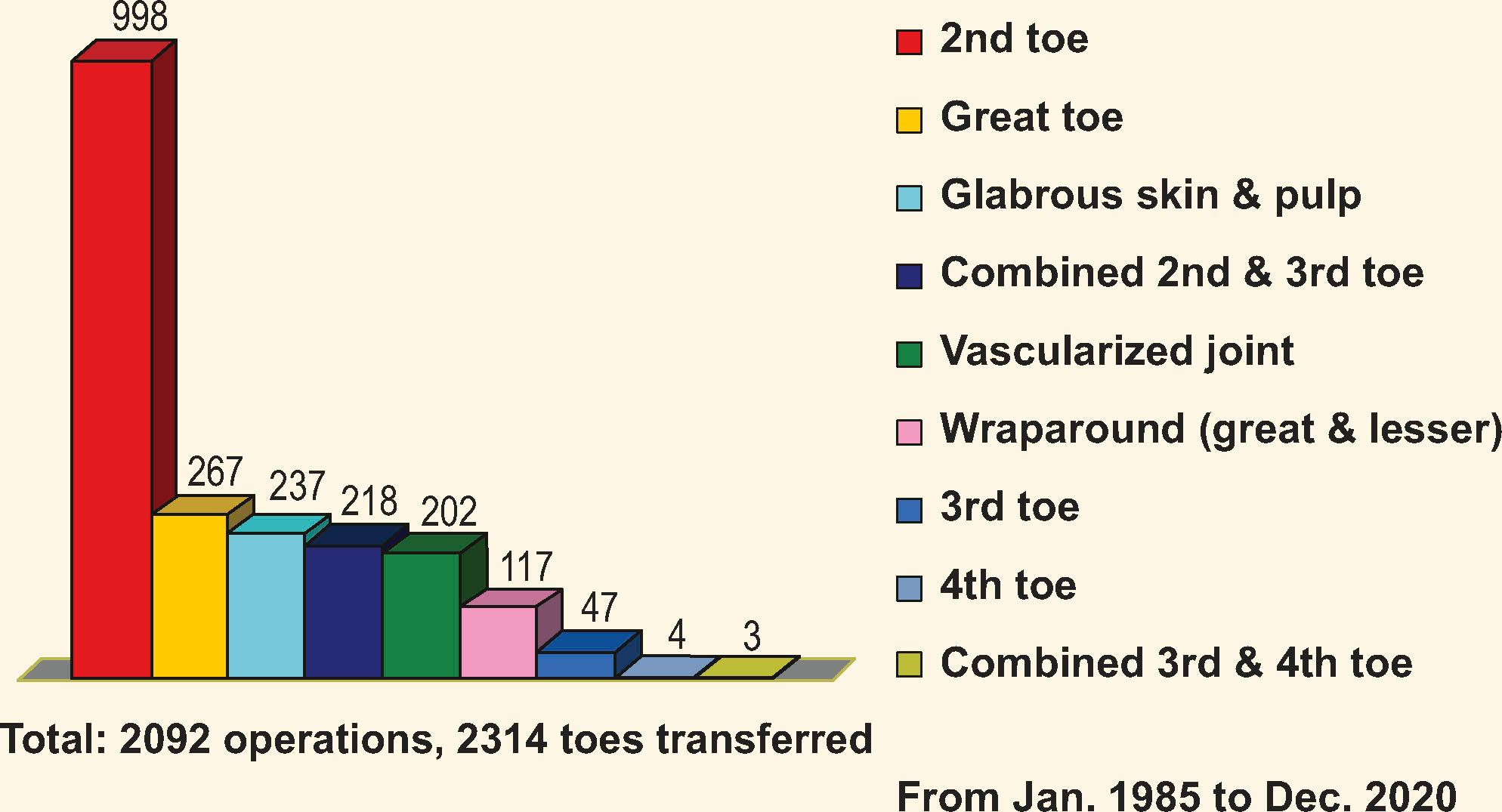
The initial management of the potential toe-to-hand transplantation patient is similar to any other trauma or patient requiring digital replantation, with resuscitation and management of concomitant life-threatening injuries if necessary, and appropriate preservation of the amputated digits. Initial assessment of the injured hand allows preemptive discussion of toe-to-hand transplantation with the patient, especially when the possibility of a successful replantation is in doubt, such as in severely avulsed, crushed, or multiple amputations. In particular, patients whose occupation requires a high-demand use of their hands or those with special needs and hobbies requiring a fine degree of dexterity and ten fingers, e.g., musicians or athletes, should be given all information available concerning different reconstructive options. If there is significant tissue damage, or anticipated tissue lack following debridement, the use of pedicled groin flap with or without iliac bone graft to replace missing soft tissue and bone should be considered at the time of the initial operation and discussed with the patient ( Fig. 14.2 ).
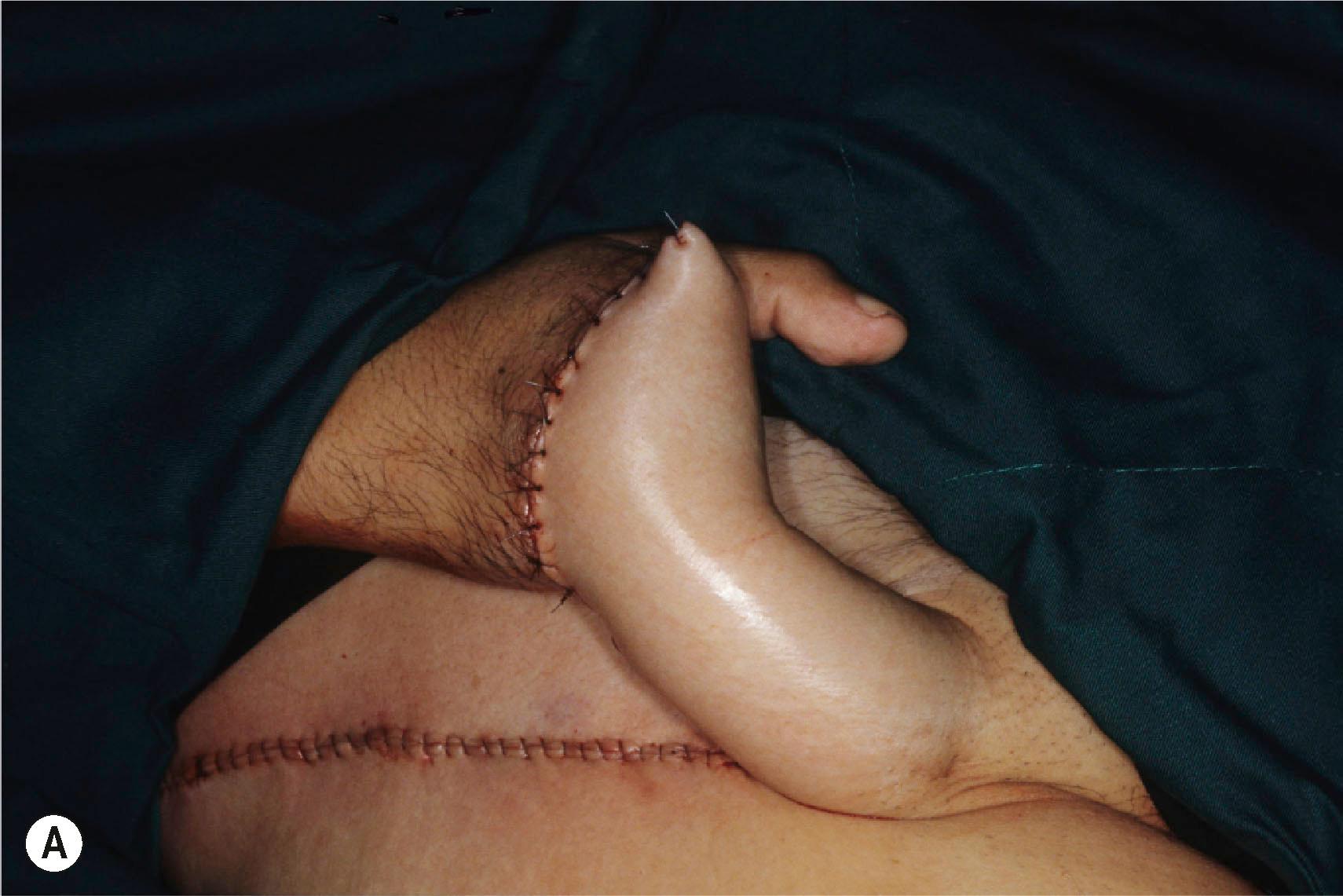
Anticipation of either primary or secondary toe-to-hand operations ensures careful preservation of all viable structures at the initial debridement or following failed replantation. Excessive shortening of structures in order to achieve direct wound closure or the use of local and regional flaps should be avoided and electively replaced by distant pedicled flaps such as the groin flap that allows for: (1) maintenance of all important structures in the amputation stump; (2) primary closure at the foot donor site; (3) enough soft tissue to create adequate webspaces and avoid skin grafts in the hand improving overall cosmetic appearance; and (4) preservation of potential recipient vessels in the hand for microsurgical toe transplantation. Although some reports have suggested other methods of additional soft-tissue harvest with the toe transplantation, either as a single-stage microvascular procedure with combined free flaps, or the use of native foot tissue, we still recommend the groin flap for the majority of cases; it is simple and reliable and leaves an almost negligible donor scar. In some severe cases of extensive soft-tissue loss, a pedicled anterolateral thigh (ALT) flap in sandwich technique fashion could be an alternative.
As the use of intraosseous wires is an effective method of osteosynthesis and only requires 0.5 cm of bone for wire placement, as much remnant bone should be preserved as possible. In transjoint amputations, any intact articular cartilage and accompanying ligaments should be preserved to facilitate joint reconstruction with disarticulated toe joints. Amputations at the level of the thumb metacarpals can be augmented with the use of bone blocks, thus avoiding the need for a transmetatarsal osteotomy in great-toe harvest, as preservation of the metatarsophalangeal joint is important for foot function and appearance.
Avulsed or shredded extensor and flexor tendons should be debrided but never sacrificed for the sole purpose of obtaining wound closure. In fingers, preserving the native intrinsic extensor apparatus as far as possible, especially over the proximal interphalangeal joint, allows preservation of the arrangement of the intrinsic and extrinsic extensor systems following reconstruction. Similarly, preserving the insertion of the flexor digitorum superficialis, wherever possible, has proved useful in achieving better functional results.
Excessive shortening and the use of cauterization of arterial and venous ends are to be avoided in order to minimize intimal damage and preserve length, avoiding more extensive foot dissection and the need for vein grafts, which prolong the operation and increase complications. The same applies to nerves. Traditional teaching of the “pull and cut” method for prevention of neuromas in amputated stumps is to be avoided, as sensory recovery is much faster when nerve length is preserved and neurorrhaphy performed nearer to the transferred toe. All neurovascular bundles should be tagged carefully with 10-0 sutures to ensure easier identification at the subsequent reconstruction.
The first ever reported toe-to-hand transfer was performed in a staged, pedicled manner on a 5-year-old child over a four-week period of time by Carl Nicoladoni in 1897. Unfortunately, the resultant transfer was stiff due to prolonged immobilization but still superior to the tubed pedicled flaps popular at that time. Davis was the first to combine staged transfer with microanastomosis of the dorsalis pedis artery, opening the door for many innovations to follow. But it was not until 1967 that the first microvascular toe-to-thumb transplantation was performed by Yang and Gu, who transplanted the second toe to the thumb. Notably, Buncke and Schulz's experimental work on monkeys preceded Yang's operation by one year and probably inspired Cobbett, who successfully transplanted the great toe to the thumb in 1969. Follow-up of Cobbett's first patient at 30 years showed good subjective sensation and no evidence of osteoarthritis.
Partial toe transfer, another frontier in toe-to-hand surgery, was deemed feasible in 1979 after Buncke and Rose performed the first neurosensory pulp flap for finger tip reconstruction. Koshima further pushed the limits of microsurgery by performing, for the first time, a free vascularized nail graft in 1988.
The success of toe-to-hand transfer in adults encouraged pediatric toe-to-hand transfer with O’Brien first reporting the procedure for congenital absence of the thumb and Gilbert and Cooney and Wood for the replacement of congenitally missing fingers.
The long and incredible history of toe-to-hand transfer has rendered it the current “state of the art” with the focus now on refinements of the functional and aesthetic results, long-term and patient-reported outcomes, and strategic guidelines. Toe-to-hand transplantations for traumatic and congenital hand defects will remain an important tool in the armamentarium of the reconstructive microsurgeon.
Careful patient selection is the key to success. Age in itself is not a contraindication for microsurgical toe-to-hand surgery. Instead, it may impact sensory recovery and range of motion, with the best results achieved in younger patients. Ideal patients should be highly motivated, clear about their needs, with realistic goals and in good health. Decision-making for each patient is individualized not simply for the injury status but also to take into account the hand dominance and occupation as well as socioeconomic status.
The time window once advocated by Godina for microsurgical reconstruction of lower extremity is not applicable in toe-to-hand surgery. Acute, subacute, and chronic reconstructions cause confusion and have no significant impact on the result and, therefore, are better to be avoided; primary and secondary reconstructions should be used, instead. Primary refers to microsurgical reconstruction done at any time as long as the wound has not healed yet, while secondary refers to transplantation after the wound has healed. With that understanding, secondary toe-to-hand procedures may ensure better wound control and definition of the injury zone, while primary reconstruction allows one-stage procedure, earlier rehabilitation, and subsequent return to work, as advocated by several authors. In our study of 26 primary cases versus 96 secondary cases, there was no significant difference in terms of flap survival rates, vascular re-exploration rates, recipient site complications including infection, or requirement for secondary revision. In a well-informed and motivated patient without extensive soft-tissue loss or other significant injuries of the ipsilateral upper limb, primary toe-to-hand transplantation offers the ideal method of replacing digit loss. It is worth noting though that earlier transfer may also result in better sensory recovery than delayed transfer. On the other hand, the procedure should be postponed or not even performed in patients who are unsure about their decisions and who cannot undergo rehabilitation as expected.
The functional thumb depends on adequate length, sensibility, stability, and the function of the thenar muscle group to perform opposition. Microvascular toe-to-thumb transplantations can achieve the first three objectives in a single stage with a superior aesthetic result; however, opposition depends on the function of the thenar muscles and could benefit from additional procedures when compromised. The function of the thumb decreases by 50% once the amputation level is proximal to the interphalangeal joint and reaches 100% once it crosses the metacarpophalangeal joint. Amputations distal to the interphalangeal joint are generally well tolerated but, in certain patients, the additional length, stability, and sensibility from a transplanted distal toe transfer is desired and can be proposed as an option.
Various classifications and reconstructive algorithms exist for thumb defects, although the underlying principles relate mainly to the types of tissue and the length of thumb missing. Toe-to-thumb transplantations can be successfully performed with various modifications of the great toe, including whole great toe, trimmed great toe, great-toe wraparound flaps, pulp flaps, and the second toe. The decision to use which toe or its variation should be individualized not only to the thumb defect and the patient's needs, but also with careful consideration of the donor site. In general, thumb reconstruction using the great toe or its variants provides better functional outcomes in terms of tripod pinch, side-to-side and pulp-to-side pinch, as well as appearance than the lesser toes do, although augmentation procedures for second toes to improve bulk have been described. If the great toe is used, at least 1 cm of the proximal phalanx should be preserved in the foot to ensure better push-off and preservation of foot appearance; the great toe is therefore an ideal option for thumb amputation levels distal to the mid-metacarpal shaft. In a more proximal amputation, additional challenges are inadequate bone stump length and thenar muscle function. The first can be overcome by a transmetatarsal transfer of the second toe or preliminary distraction lengthening of the existing metacarpal ray or interpositional bone grafting between the transferred toe and the metacarpal without sacrificing the base of proximal phalanx or the metatarsophalangeal joint of the great toe. The destruction of the thenar musculature and the subsequent loss of opposition, however, may necessitate pronation osteosynthesis, but is better corrected by primary opposition transfer in the authors' experience.
Classification of finger defects is similar to the thumb and pertains to the type of tissue and length of finger missing, with the additional consideration of which finger is involved and whether there are single or multiple amputations. The definition of proximal or distal amputations is determined by its relation to the insertion of the flexor digitorum superficialis tendon. Toe transplantation to more distal finger amputations can be achieved by a wide variety of options, including the use of vascularized nail grafts, pulp flaps, wraparound flaps, and partial second toes, depending on what tissues are missing. These operations are rewarding due to the restoration of high-density pulp sensation, fine pinch, and cosmetic appearance of the nail. A partial second-toe flap which includes the distal interphalangeal joint or both the proximal and distal interphalangeal joints is indicated in amputations distal to the flexor digitorum superficialis insertion. In contrast, a whole second-toe flap is indicated in carefully selected patients with more proximal amputations; the ideal level, however, is distal to the middle of the proximal phalanx as reconstructions for more proximal amputations usually result in a slightly shorter finger.
Decision-making for patients with multiple finger amputations is largely guided by the specific occupational and cosmetic needs of the patient. In general, two adjacent fingers should be reconstructed wherever possible to allow a stable tripod pinch or hook grip. Preferential reconstruction of the radial two fingers should be recommended for patients who require fine pinch and the ulnar two digits for manual workers who require a strong grip. However, multiple finger amputation could be too complicated to be addressed with toe transfer alone, and additional procedures such as lengthening and ray amputation could be necessary, as well.
The term “metacarpal hand” refers to a hand injury with multiple finger amputations at the level of the metacarpophalangeal (MCP) joint, or immediately proximal or distal to it. Delitala was perhaps the first to coin this term and, since then, various classification systems have been proposed, with varying levels of clinical usefulness. A classification system based on reconstructive options and different stages of injury has proved useful in our experience ( Tables 14.1 & 14.2 ). This takes into account the level of finger amputations and thumb involvement, and provides guidelines for the reconstructive technique as well as prediction of the functional outcome after reconstruction. Type I refers to four-finger proximal amputations without the thumb or only distal-thumb involvement (no thumb reconstruction necessary). In type IA where the amputation level is distal to the MCP joint, the focus is on the selection of two separate toes or combined second–third-, or third–fourth-toe transplantations depending on the presence of webspace ( Fig. 14.3 ). To ensure that the different digits curve around an object more evenly in grasp prehension, the length of the remaining amputation stumps should not be longer than that of a normal little finger when considering a combined second- and third-toe transfer. For type IB, where the amputation level is through the joints with intact articular surfaces, combined second and third toes are harvested as composite joint transfers. For type (IC) where the amputation level is proximal to the MCP joints, combined second and third toes as transmetatarsal transfers is indicated. Reconstruction of two adjacent fingers allows for a stable tripod pinch, although reconstruction of all four fingers is possible in certain selected patients with acceptable donor site morbidity ( Fig. 14.4 ).
| Subtype | Thumb amputation levels | Finger amputation levels |
|---|---|---|
|
Amputation distal to the interphalangeal joint |
|
| Subtype | Thumb amputation level | Reconstructive options | Stage |
|---|---|---|---|
| IIA | Distal to the metacarpal neck | Whole or trimmed great toe | Simultaneous |
| IIB | Proximal to the metacarpal neck with adequate thenar muscle function | Whole or trimmed great toe ± lengthening or bone augmentationTransmetatarsal second-toe transfer | Simultaneous |
| IIC | Any level with inadequate thenar musculature | Same as in IIA or IIBOpponensplasty | Staged |
| IID | Any level with damaged carpometacarpal joint | Same as in IIA or IIBImmobile thumb post | Staged |
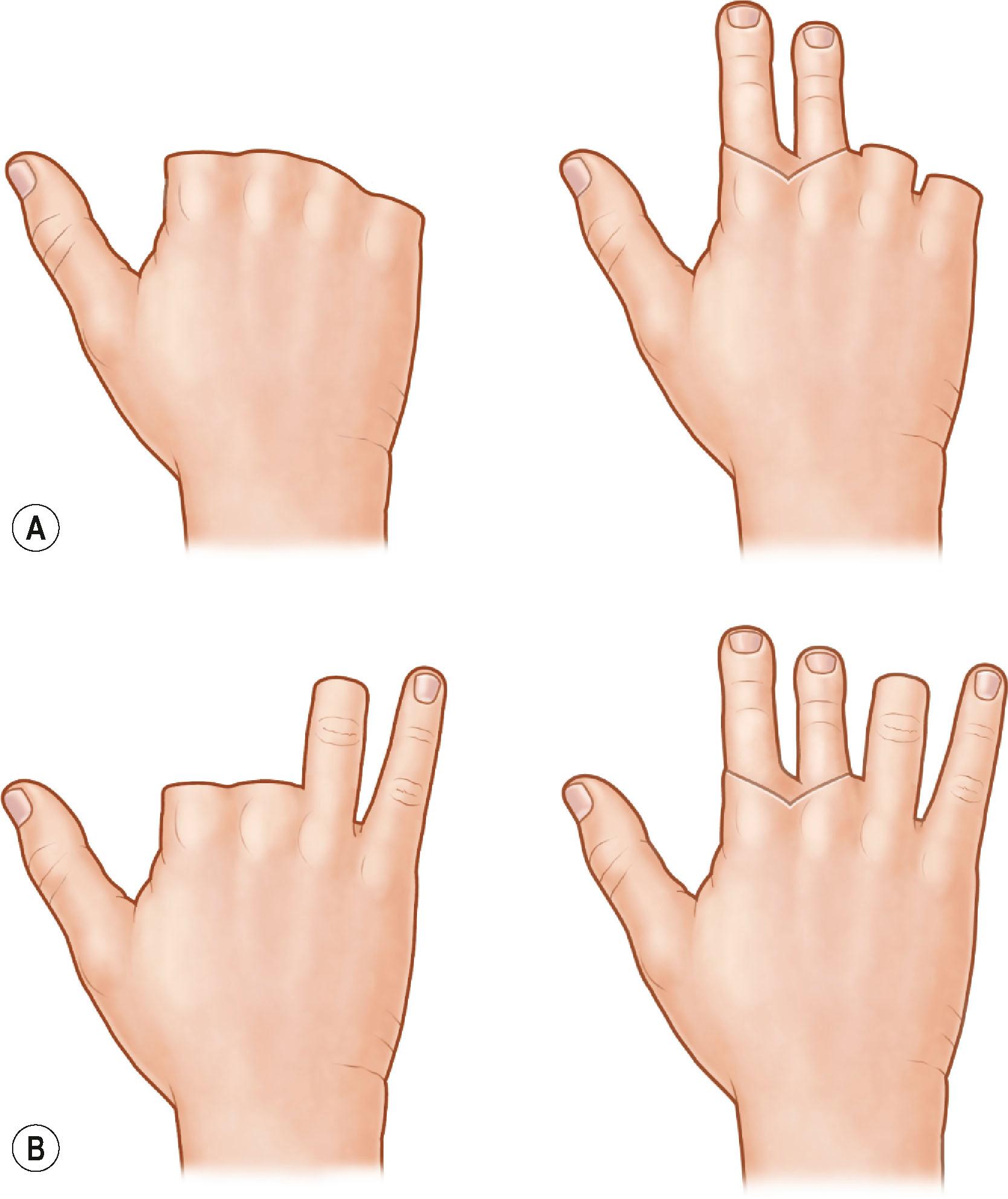
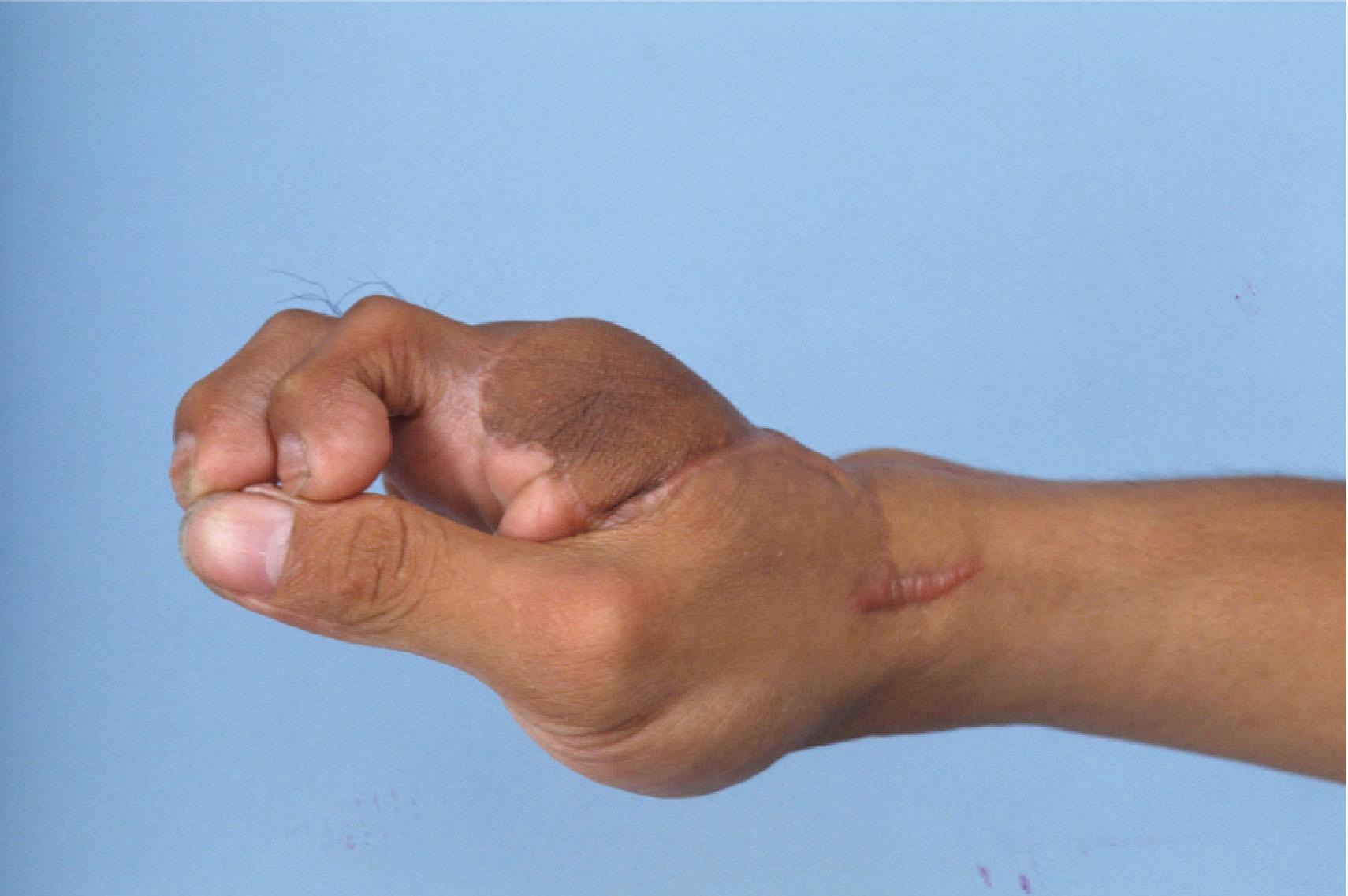
Type II injuries refer similarly to four-finger proximal amputations but with various levels of thumb involvement proximal to the base of the proximal phalanx. The reconstruction of fingers with toe transplantations follows a similar decision-making process as for type I defects, but reconstruction of the thumb is determined by the presence or absence of a functional thenar musculature. If the thenar muscles are intact or possess adequate function (types IIA and IIB), a one-stage procedure to reconstruct the thumb and two adjacent fingers is recommended. If the thenar muscles are missing or have inadequate function (IIC), the thumb reconstruction should follow finger reconstructions in a second stage and only after the thumb position is determined by the aid of prosthesis while the fingers assume their final positions ( Fig. 14.5 ). Either pronation osteosynthesis or an opposition transfer can be performed to provide better pinch.
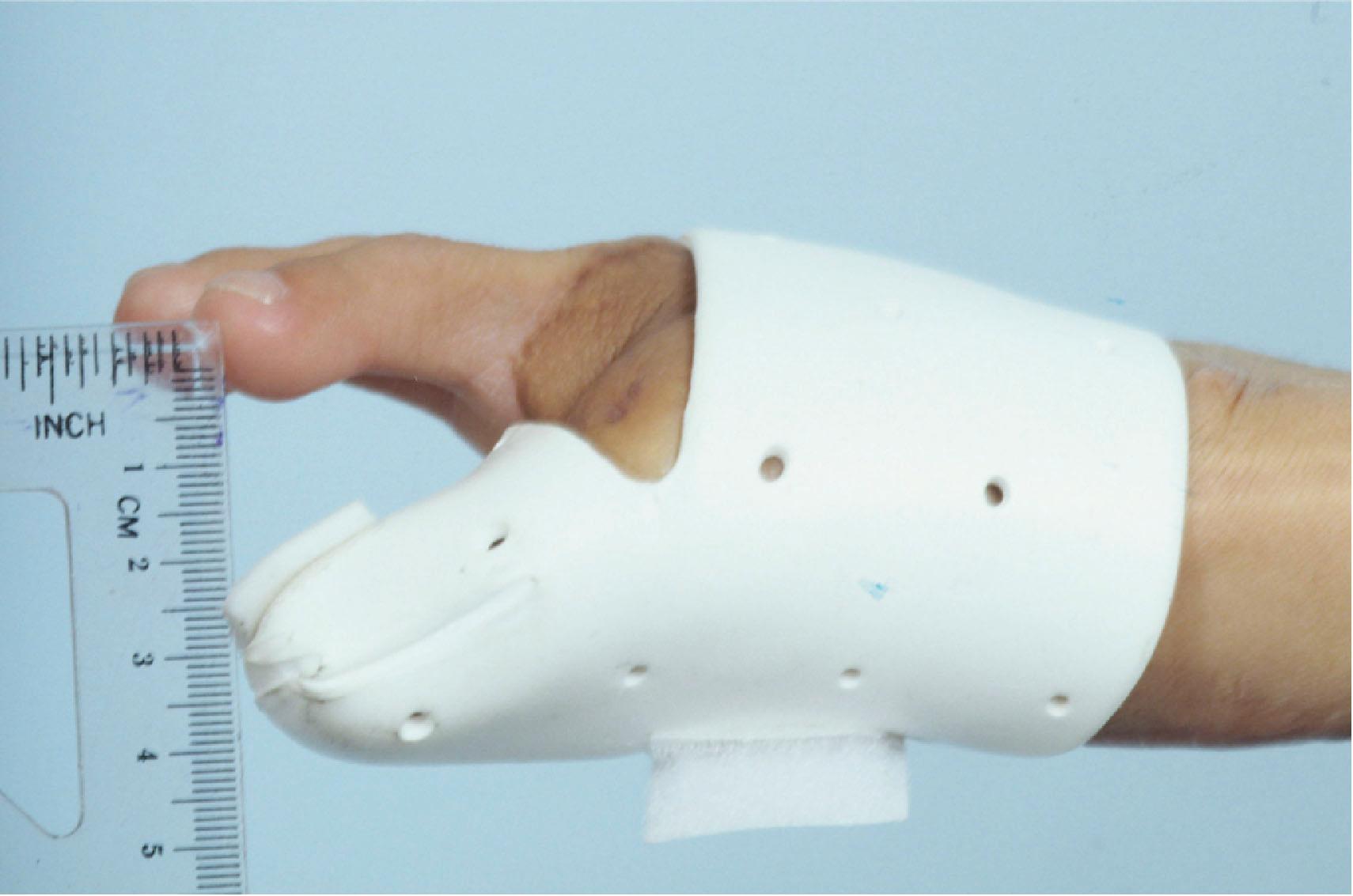
Decision-making in bilateral metacarpal hand injuries requires a careful balance of the severity of injury (type I or II), patient's needs, and donor site morbidity. Other options should also be discussed with the patient. Type II injuries are much more difficult than type I, requiring up to but not exceeding five toes to achieve a functional level of prehension. In general, the use of a great toe, usually from the left foot, is sacrificed for dominant thumb reconstruction together with a combined two-toe reconstruction from the opposite foot to achieve a tripod pinch. In the non-dominant hand, single-digit pulp-to-pulp pinch is considered adequate with the use of a lesser toe for thumb reconstruction. Although the option of sacrificing both great toes or more lesser toes for hand reconstruction may seem attractive, we have found that the donor morbidity reaches a level that is incompatible with activities of daily living. In instances where multiple toes are needed, the patient needs to participate fully in the decision-making with regard to the foot morbidity, especially in certain populations where patients are far less tolerant of sacrificing their toes to reconstruct their hands ( Fig. 14.6 ).
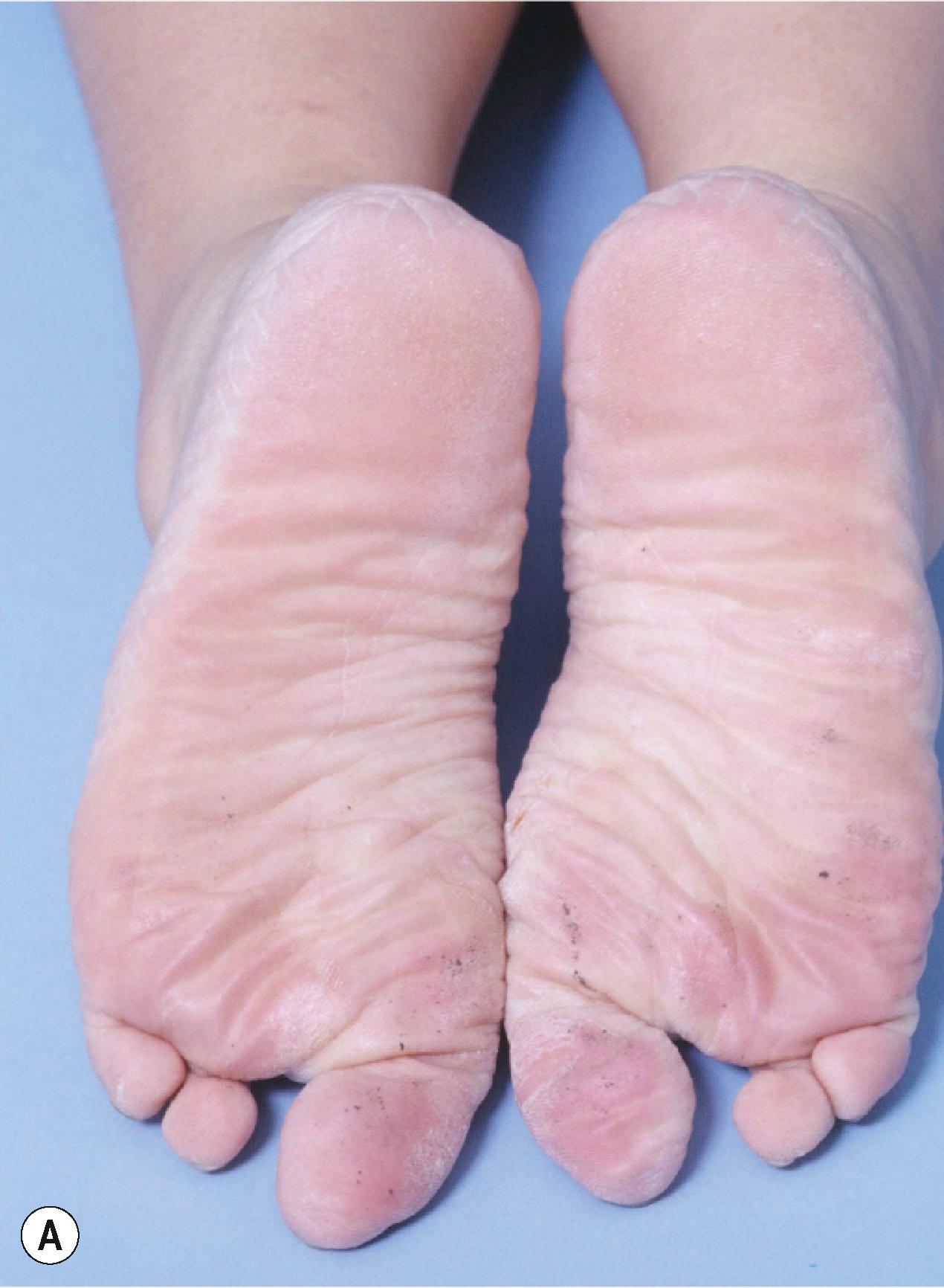
For the metacarpal hand, the same strategies and tactics described above apply. In the type I metacarpal hand (thumb and one finger preserved beyond the functional length), multiple-toe transplantation may be warranted and may yield significant correction of hand function. Toe transfer would add more fingers, improving finger length, form and function, and the hand cascade. The reconstructed fingers do not have to be adjacent to each other.
In type II metacarpal hand (one or two fingers are preserved beyond functional length), the timing of thumb reconstruction depends on the status of the basal joint and thenar muscles. When these are adequate, simultaneous toe transfer for the thumb and the fingers can be performed. Otherwise, finger reconstruction is performed first. In type II, the goal of toe transfer is to reconstruct both the thumb and adjacent two fingers if the hand lacks one or two radial fingers. If a radial finger is present, improved grip and overall hand cascade may still be improved by ulnar and central placement of additional toes.
Despite the many configurations and combinations of toe-to-hand transplantations available, a few important principles exist for all cases which, when adhered to, allow easier dissection, reduced foot morbidity, and improved overall functional and aesthetic outcomes.
Become a Clinical Tree membership for Full access and enjoy Unlimited articles
If you are a member. Log in here